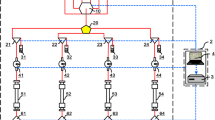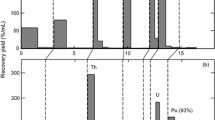Abstract
In recent years the purification and/or pre-concentration of radionuclides before the measurement has grown increasing interest in analytical chemistry. In this study, a new compact and portable stand-alone equipment permitting automatisation of various separation tasks is developed. The new system allows performing quick and reliable automated separation of the selected radionuclide. Since there is no need for permanent manual control of the separation procedures (automatic loading of the sample, washing and stripping solution on the column are controlled via a computer program) the system can be operated overnight. The new system posses the possibility of more variable control for the separation process via new developed user-friendly software, is shielded against the chemical vapors and could be universally equipped with any available chromatographic column. For the automated separation of U, Pu and Am isotopes (achieved recoveries were in the range of 65–95 %, depending on the element separated. The data, presented, show that the application of the module should be also straightforward for other elements: simply by changing the chromatographic columns with the resin having high chemical selectivity for the target ion. The developed separation column module, software and hardware can be readily adapted in any laboratory to meet defined analytical requirements.



Similar content being viewed by others
References
Boulyga SF (2011) Mass spectrometric analysis of long-lived radionuclides in bio-assays. Int J Mass Spectrom 307(1–3):200–210
UNSCEAR (2000) The 2000 report to the general assembly with scientific annexes. UNSCEAR, New York
Cornett J et al (2009) Polonium-210: lessons learned from the contamination of individual Canadians. Radiat Prot Dosimetry 134(3–4):164–166
Lloyd NS, Chenery SRN, Parrish RR (2009) The distribution of depleted uranium contamination in Colonie, NY, USA. Sci Total Environ 408(2):397–407
Bakhmutsky M et al (2012) Long-term depleted uranium exposure in gulf war veterans does not cause increased chromosome aberrations in peripheral blood lymphocytes measured by fish whole chromosome painting. Environ Mol Mutagen 53:S26
Evseeva T et al (2012) Estimation of radioactive contamination of soils from the “Balapan” and the “Experimental field” technical areas of the Semipalatinsk nuclear test site. J Environ Radioact 109:52–59
Stohl A, Seibert P, Wotawa G (2012) The total release of xenon-133 from the Fukushima Dai-ichi nuclear power plant accident. J Environ Radioact 112:155–159
Zoriy MV et al (2005) Determination of Sr-90 and Pu isotopes in contaminated groundwater samples by inductively coupled plasma mass spectrometry. Int J Mass Spectrom 242(2–3):203–209
Almayahi BA, Tajuddin AA, Jaafar MS (2012) Effect of the natural radioactivity concentrations and Ra-226/U-238 disequilibrium on cancer diseases in Penang, Malaysia. Radiat Phys Chem 81(10):1547–1558
Hamideen MS, Sharaf J (2012) Natural radioactivity investigations in soil samples obtained from phosphate hills in the Russaifa region, Jordan. Radiat Phys Chem 81(10):1559–1562
Meresova J, Watjen U, Altzitzoglou T (2012) Determination of natural and anthropogenic radionuclides in soil-results of an European Union comparison. Appl Radiat Isot 70(9):1836–1842
Zoran M, Savastru R, Savastru D (2012) Ground based radon (Rn-222) observations in Bucharest, Romania and their application to geophysics. J Radioanal Nucl Chem 293(3):877–888
Tsabaris C et al (2012) Distribution of natural radioactivity in sediment cores from Amvrakikos Gulf (Western Greece) as a part of IAEA’s campaign in the Adriatic and Ionian Seas. Radiat Prot Dosimetry 150(4):474–487
Zoriy MV et al (2005) Determination of Ra-226 at ultratrace level in mineral water samples by sector field inductively coupled plasma mass spectrometry. J Environ Monit 7(5):514–518
Santos JS et al (2010) Uranium determination using atomic spectrometric techniques: an overview. Anal Chim Acta 674(2):143–156
Becker JS (2003) Mass spectrometry of long-lived radionuclides. Spectrochim Acta B Atomic Spectrosc 58(10):1757–1784
Kim CS et al (2007) Determination of Pu isotope concentrations and isotope ratio by inductively coupled plasma mass spectrometry: a review of analytical methodology. J Anal At Spectrom 22(7):827–841
Hou XL, Roos P (2008) Critical comparison of radiometric and mass spectrometric methods for the determination of radionuclides in environmental, biological and nuclear waste samples. Anal Chim Acta 608(2):105–139
Thakur P, Mulholland GP (2012) Determination of Np-237 in environmental and nuclear samples: a review of the analytical method. Appl Radiat Isot 70(8):1747–1778
Shi KL et al (2012) Determination of technetium-99 in environmental samples: a review. Anal Chim Acta 709:1–20
Zoriy MV et al (2004) Determination of Pu in urine at ultratrace level by sector field inductively coupled plasma mass spectrometry. Int J Mass Spectrom 232(3):217–224
Douville E et al (2010) Rapid and accurate U-Th dating of ancient carbonates using inductively coupled plasma-quadrupole mass spectrometry. Chem Geol 272:1–11
Kim CK et al (2008) Development and application of an on-line sequential injection system for the separation of Pu, 210Po and 210Pb from environmental samples. Appl Radiat Isot 66:223–230
Varga Z et al (2010) Determination of rare-earth elements in uranium-bearing materials by inductively coupled plasma mass spectrometry. Talanta 80:1744–1749
St-Amant N et al (2011) Radiostrontium and radium analysis in low-level environmental samples following a multi-stage semi-automated chromatographic sequential separation. Appl Radiat Isot 69(1):8–17
McAlister DR, Horwitz EP (2009) Automated two column generator systems for medical radionuclides. Appl Radiat Isot 67(11):1985–1991
Bond AH et al (2003) A compact automated radionuclide separation system for nuclear medical applications. Czech J Phys 53:A717–A723
Kim CS et al (2000) Rapid determination of Pu isotopes and atom ratios in small amounts of environmental samples by an on-line sample pre-treatment system and isotope dilution high resolution inductively coupled plasma mass spectrometry. J Anal Atomic Spectrom 15(3):247–255
Zoriy P et al (2010) Development of a relatively cheap and simple automated separation system for a routine separation procedure based on extraction chromatography. J Radioanal Nucl Chem 286(1):211–216
Acknowledgments
The authors would like to thank Mr. G. Henschke for the technical realisation of the automated separation column module TSM. The assistance of the staff of the Radioanalytical Laboratory in performing and testing the module is very much appreciated.
Author information
Authors and Affiliations
Corresponding author
Rights and permissions
About this article
Cite this article
Zoriy, M.V., Flucht, R. & Burow, M. Portable automated separation system for routine purification and/or pre-concentration of radionuclides based on column chromatography. J Radioanal Nucl Chem 297, 107–113 (2013). https://doi.org/10.1007/s10967-012-2315-8
Received:
Published:
Issue Date:
DOI: https://doi.org/10.1007/s10967-012-2315-8




